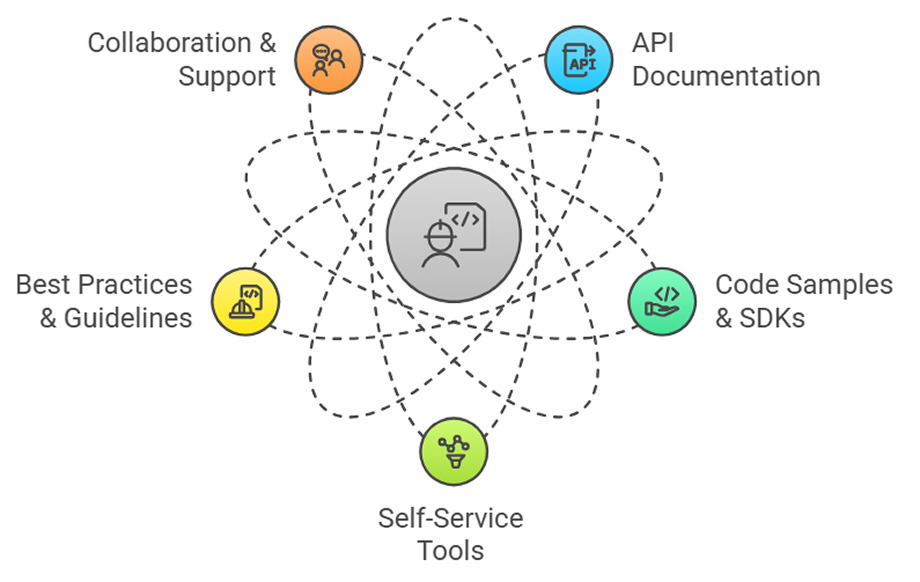Developer Portal
Today, software developers integrate several external APIs or tools to build applications. With so many tools in use, they need to have fast and easy access to everything. This is where developer portals come in. A developer portal acts as
a single point of access where developers can efficiently search for and manage their resources and, therefore, plays a very important role in this process.
What is a Developer Portal?

A developer portal (Dev Portal) is a centralized platform that provides developers with everything they need to work efficiently. It typically includes:
- API documentation : Clear and structured guides on how to use APIs, SDKs, and tools.
- Code samples & SDKs : It includes ready-to-use code snippets and SDKs to help developers get started quickly.
- Self-service tools : Features like API key management, testing environments, and debugging tools.
- Best practices & guidelines : Coding standards, security protocols, and workflow guidelines.
- Collaboration & support : Discussion forums, FAQs, and customer support for troubleshooting issues.
Think of an internal developer portal as a digital library for tools or APIS. It makes development easier and helps developers work smarter. Many well-known tech companies provide top-notch developer portals like
Google Cloud and Stripe.
Key Benefits of Developer Portals
A well-designed developer portal offers several key benefits:
-
- Saves time and improves efficiency
- Without a developer portal, developers might spend several hours looking for tools or documentation.
- A centralized platform ensures that everything (APIs, SDKs, and troubleshooting guides) is easy to find.
- This reduces time wasted on unnecessary tasks and allows developers to focus on building great software.
- Enhances developer experience
A good developer portal creates a smooth and hassle-free workflow by:- Making onboarding easier for new developers
- Providing quick access to APIs, SDKs, and documentation
- Simplifying API integration
With fewer obstacles, developers can work more efficiently and productively.
- Encourages reuse of APIs and services
- With a well-organized developer portal, developers are more likely to reuse previously created APIs and components instead of having to develop them anew.
- This enhances productivity and efficiency while practicing the don’t repeat yourself (DRY) principle.
- Boosts collaboration and knowledge sharing
Software development is a team effort, and a developer portal helps teams share knowledge and collaborate better by:- Providing a common space for sharing best practices
- Allowing teams to give feedback and improve documentation
- Helping different teams work together more effectively
When information is easy to find, teams can solve problems faster and work more smoothly.
- Ensures security and compliance
Security is important when working with APIs and sensitive data. A developer portal helps maintain security by:- Managing API access through authentication and authorization
- Keeping API keys and tokens secure
- Providing clear security guidelines to follow
By making security a priority, organizations can prevent risks and stay compliant with industry standards.
- Improves API adoption and external developer engagement
Companies with external developers or partners find it easier to access APIs with a developer portal. It provides:- Clear API documentation with step-by-step guides
- Code samples and tutorials to help developers get started quickly
- Testing tools so developers can try out APIs before integrating them
- Saves time and improves efficiency
A well-designed developer portal helps attract more developers, improve API adoption, and create a strong developer community.
Key Features of an Effective Developer Portal

Not all developer portals are the same. To truly benefit developers, a portal must have certain essential features:
- User friendly interface
- Users can be frustrated by providing a confusing interface. So, a developer portal should be well-organized and easy to navigate. It should provide a smooth user experience.
- Comprehensive documentation
Outdated or unclear documentation can lead to errors and wasted time. A great developer portal ensures that:- API documentation is regularly updated with clear, step-by-step instructions.
- Guides and tutorials provide accurate information to help developers get started quickly.
- Interactive tools and API testing
Modern developer portals include interactive API explorers that allow developers to test API requests in real time. These tools help by:- Speeding up debugging
- Simplifying API integration
- Providing a hands-on experience before full implementation
- Clear authentication and access controls
Security is crucial when working with APIs. A developer portal should include:- Easy management of API keys and tokens
- Secure authentication methods (such as OAuth 2.0 or JWT)
- Role-based access control (RBAC) to manage permissions
- Feedback and community support A good developer portal should foster collaboration and knowledge sharing by offering:
- Discussion forums where developers can ask questions and share solutions.
- Chat support and FAQs for quick troubleshooting.
- A place to suggest improvements and contribute feedback.
Conclusion
A developer portal is one of the most crucial components of the modern software development cycle, as it serves as a central repository for APIs, documentation, tools, and support. A secure portal with interactive tools and robust
documentation saves time and improves productivity and collaboration. For businesses, a developer portal increases the consumption of APIs from third-party developers while also ensuring adherence to security policies. It also supports
developing internal or external tools that improve development and simplify integration. A well-designed developer portal is a great investment as it speeds up the tedious software development process for both developers and organizations.